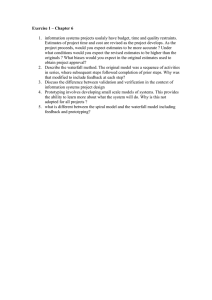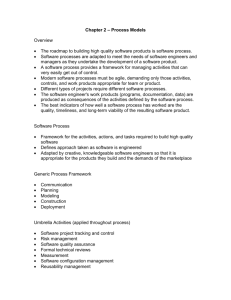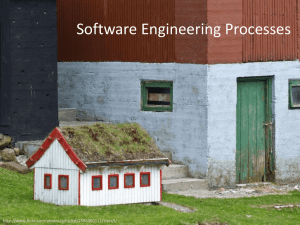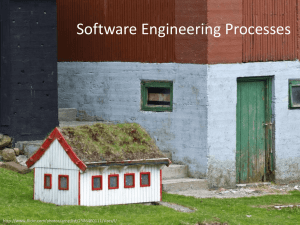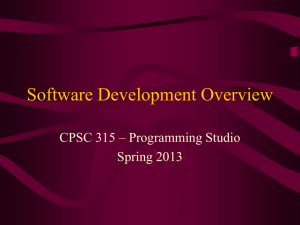Software Engineering Processes
advertisement
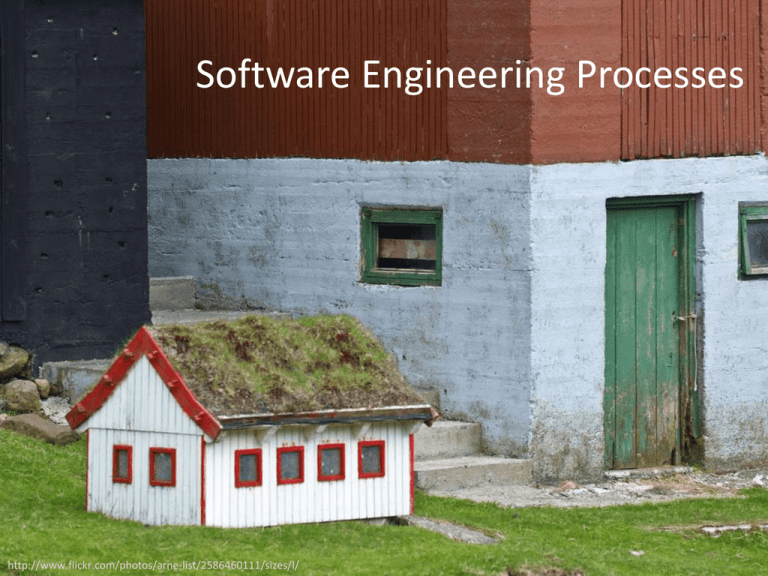
Software Engineering Processes http://www.flickr.com/photos/arne-list/2586460111/sizes/l/ Do you want to build “dog houses” or “high rises”? If you want to build a dog house, you can pretty much start with a pile of lumber, some nails, and a few basic tools, such as a hammer, saw, and tape measure. In a few hours, with little prior planning, you'll likely end up with a dog house that's reasonably functional... If you want to build a high-rise office building, it would be infinitely stupid for you to start with a pile of lumber, some nails, and a few basic tools. Because you are probably using other people's money, they will demand to have input into the size, shape, and style of the building.... You will want to do extensive planning, because the cost of failure is high. You will be just a part of a much larger group responsible for developing and deploying the building, and so the team will need all sorts of blueprints and models to communicate with one another.... -- Grady Booch, The Unified Modeling Language User Guide http://www.amazon.com/Unified-Modeling-Language-Addison-Wesley-Technology/dp/0201571684 Process • Process is well-defined and usually involves a set of tools and techniques – Uses resources, is subject to constraints and produces intermediate and final products – May be composed of sub-processes – Has entry and exit criteria – Activities are ordered with clear relationships • Life-cycle: The process of building a product Development process • Process = a set of ordered tasks – Typical software tasks: • • • • • Figuring out what the system should do (requirements) Figuring out how the system should do it (design) Writing the code for the system (implementation) Making sure that the code is right (testing) Using the system (operation) – Should imply some planning and risk management – Different processes order tasks differently Build it and fix it Build Fix Great for a single programmer for a small project! What if you don’t know what to build? ‘ ‘ ‘’ ‘ ‘ ‘’ ‘ ` ‘ ‘`’ ` `’ `’ ‘ ‘ `’ `’ `’ ` What’s a “``’? What do we need to do? Doesn’t he know that we can’t make a `’``? Requirements Analysis • Elicit from the customer what they really need the system to do • Analyze the requirements to ensure that the requirements are correct and consistent Design • Architectural design – Figuring out the overall structure of the system • What components should be in the system? • How should the components be connected? • Program design – Figuring out how code should be organized • How should each component’s code be distributed among classes and/or functions? Implementation • Finally, we get to write some code! • Implementation also may include: – Writing comments – Writing other documentation – Helping fellow engineers with their coding – Answering questions – Reading colleagues’ code, documentation, etc – Messing around with code until it “smells good” Testing • Testing – Unit testing • Good for automatically checking individual components – System integration testing • Good for checking that components work well together – Usability testing • Good for checking user interfaces – Acceptance testing • Good for checking that the customer/user is happy Operation • The code compiles, passes all tests, and looks great on your desktop. Done, right? Wrong! • Operation often includes – Distributing code to customers/users – Providing documentation and support – Debugging, after users try out the system – Studying how well the system works in practice – Adapting the system for new markets The waterfall processes Requirements analysis Prototyping Design Implementation Testing Operation/Maintenance (No prototyping in a pure waterfall process) Drawbacks of The Waterfall Model • Non-iterative: hard to handle changes to products and activities during development (assumes requirements can be frozen) – Views software development as manufacturing process rather than as creative process – Long wait before a final product tware Engineering ocesses Continued egasinc.com/news/2011/sep/06/fontainebleau-las-vegas-developers-fight-vulture-i/ Waterfall kinds of processes Requirements analysis Prototyping Design Implementation Testing Operation/Maintainance (No prototyping in a pure waterfall process) Spiral kinds of processes Plans change every increment Deliverables change every increment Spiral kinds of processes Agile kinds of processes Do “spike” to evaluate & control risk Customer provides “stories” (short requirement snippets) Prioritize stories and plan Operation Write/run/modify unit tests Implement System and acceptance tests (Agile processes are rarely this tidy in practice) Agile Methods: Examples of Agile Process • Extreme programming (XP): Focus on simplicity and rapid iteration • Scrum: 30-day iterations; multiple selforganizing teams; daily “scrum” coordination • Crystal: a collection of approaches based on the notion that every project needs a unique set of policies and conventions Contrasting these kinds of processes Waterfall Spiral Agile Emphasizes: -Stability -Traceability -Risk management -Exploring alternatives -Flexibility -Immediacy Weakness: Requirement/design mistakes can be costly Exploring alternatives can be costly Continual rework can be costly Style: -Highly controlled -High ceremony -Moderately controlled -Moderate ceremony -Rapid & organic -Low ceremony Some definitions -“traceability”: relationships between requirements and system elements are documented -“immediacy”: getting some sort of working system to the customer as fast as possible -“rework”: redesigning the architecture and/or refactoring the program code -“controlled”: conformance to process is highly valued, even if it slows a project down -“ceremony”: how much analysis, documentation, and planning is involved When to choose a particular kind of process • Waterfall is often a good choice for small systems whose requirements can be fully understood before any design or coding. • Spiral is often a good choice for larger systems with vague requirements and many alternatives for designing and coding. • Agile is often a good choice for systems where you can rapidly create something very small but useful, and then expand from there. What kind of process would you prefer to use for…? • • • • A nuclear missile’s guidance system A web server (plain old http) A web site for people to request prayer A program that screen-scrapes Google News to watch for swine flu outbreaks • A program to steer the Mars rovers • A controller for a sprinkler system so the lawn gets less water on rainy days The story doesn’t end with operation— how do you improve the system later? • Iterative – Get the whole system working pretty well – Then add features throughout the system • Incremental – Get part of the system working really well – Then add more parts to the system You can mix & match iterative/incremental with waterfall/spiral/agile. E.g.: iterative agile How to decide on iterative vs incremental development It all comes down to where the system’s value is: Incremental is often good when most of a system’s value is tightly concentrated in a small number of components. Iterative is often good when you need to implement most of a system before you can get much value. Building an Eco-Friendly Shopping Website • What kind of process would you choose? (Waterfall, Spiral, Agile) • Incremental development, or iterative development? • What would be the system priorities? • What could change during system development? Eco-Friendly Shopping Site • What activities would you do, in what order? Eco-Friendly Shopping Site • Requirements to consider: – Reduce physical waste – Use low energy servers – Supply eco-friendly products – Allow customers to buy items and pay money Review prototypes with customer (and/or users), document the results Paper prototypes Lightweight prototypes Documentation These “throwaway” prototypes are cheap to make because they are usually not interactive. http://www.flickr.com/photos/carolshergold/1748174721/sizes/o/ http://www.flickr.com/photos/carolshergold/1920638621/sizes/o/ http://www.flickr.com/photos/carolshergold/1921464196/sizes/o/ Designs and Frameworks • Would you pick a language first, or a design first? • Do you think it matters? Alternative Designs Possible Implementations • One setup: – Asynchronous, single-process event-driven server (node.js?) – Redis database • Another setup: – LAMP: Linux, Apache, MySQL, PHP Eco-Friendly Shopping Site • What does the resulting process look like? Spiralling and beyond Pay attention to users, discover new requirements - Spiral, spiral, spiral http://www.flickr.com/photos/villes/696080093/sizes/o/
